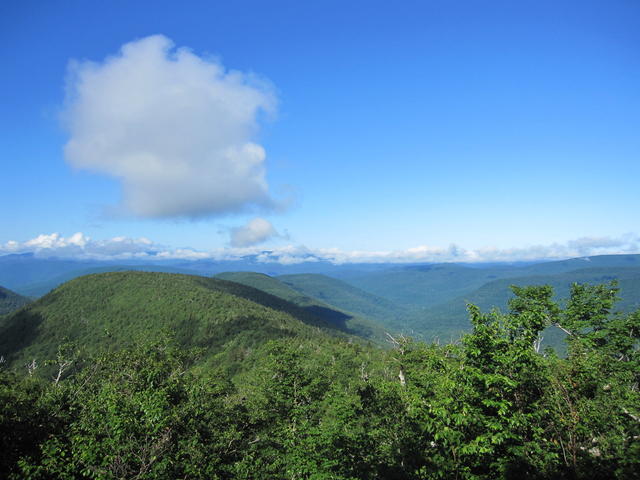Home » Regions » North America » Northern Forests » Atlantic Highlands » Northeastern Highlands » Catskill High Peaks
Catskill High Peaks
Last updated: August 19th, 2020
Page contents
↑About the Catskill High Peaks
The Catskill High Peaks is a region in New York State that contains the higher elevation portion of the Catskills. More broadly, it is considered part of the Appalachians; ecologically, it is an isolated part of the Northern Forests due to its higher elevation and colder climate causing it to support coniferous forest, unlike the deciduous temperate forests that surround it at lower elevations.Although called a mountain range, geologically, this region originated as dissected plateau. It is formed from erosion-resistant layers of sandstone and conglomerate, which cap the more erodible layers of shale, and siltstone that form the surrounding Northern Allegheny Plateau. The landscape has also been shaped by glaciation, which widened the valleys and rounded the mountaintops. Glacial till is shallow, discontinuous when present, and often absent altogether; the bedrock, sandstone, conglomerate, and shale, is often exposed. Elevations range from 1,000-4,180 ft (305-1274m) and local relief ranges from 1,100-2,000 ft (335-610m.)
The region has a humid continental climate. Elevations here are high enough to produce substantial climate changes with altiude; the highest areas have some of the highest precipitation of anywhere in the region, reaching over 60 inches of rain equivalent annually, with much of this falling as snow in winter. The frost-free period also varies, but tends to be short, from 90-125 days. The steep topography, cold temperatures, and short growing season make this region unsuitable for western Agriculture.
Above about 3,000 feet in elevation, forests are dominated by red spruce (Picea rubens), balsam fir (Abies balsamea), and yellow birch (Betula alleghaniensis), with understories of hobblebush (Viburnum lantanoides). Summits support scrub growth of huckleberry, lowbush blueberry (Vaccinium angustifolium), and mountain laurel (Kalmia latifolia), with stunted pitch pine (Pinus rigida) and bear oak (Quercus ilicifolia). On north-facing slopes and cool, moist areas, northern hardwood forests can be found, which include large-tooth aspen (Populus grandidentata), quaking aspen (Populus tremuloides), paper birch, and black ash (Fraxinus nigra). Below 3,000 feet, more trees from the central hardwood forest type occur, leading to a mix of American beech (Fagus grandifolia), sugar maple (Acer saccharum), red maple (Acer rubrum), eastern hemlock (Tsuga canadensis), eastern white pine (Pinus strobus), American basswood (Tilia americana), American basswood (Tilia americana), and American sycamore (Platanus occidentalis).
Although presently the area is almost entirely forested, historically, there was logging over most of the area, and most of the present forest is second-growth. However, some old growth forests remain, especially at higher elevations, with uncut stands of spruce-fir forest, old-growth scrubland on some ridges, and some other forest types. There is practically no agriculture in the region. Currently, this area is mostly utilized for tourism and recreation. The rainfall originating here is also used as a water supply for New York City, through the Ashokan Reservoir. There is extensive public land throughout the region.
This region is almost entirely surrounded by the Catskills Transition, a region of lower elevation that is still part of the same geologic feature. It also shares a small direct border with the Delaware-Neversink Highlands to the south.
 This photo was taken from atop Plateau Mountain, one of the peaks in the Catskill High Peaks region; some of the other nearby peaks are visible in the background, showing their distinctive ridge-like flat tops, reflecting that this region is actually a dissected plateau. Photo © Chris M Morris, CC BY 2.0.
This photo was taken from atop Plateau Mountain, one of the peaks in the Catskill High Peaks region; some of the other nearby peaks are visible in the background, showing their distinctive ridge-like flat tops, reflecting that this region is actually a dissected plateau. Photo © Chris M Morris, CC BY 2.0.Plant Lists & In-Region Search
We do not yet have data to generate plant lists for a region as fine-tuned as this one. However you can move up to the broader Northeastern Highlands and generate lists for that region: native plants or all plants. Or search that region's plants here:
↑References
1. Bryce, S.A., Griffith, G.E., Omernik, J.M., Edinger, G., Indrick, S., Vargas, O., and Carlson, D. "Ecoregions of New York (Poster)", U.S. Geological Survey (2010) Web.


